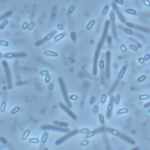Link to Pubmed [PMID] – 21169450
Appl. Environ. Microbiol. 2011 Feb;77(4):1449-59
In this study, we combined metabolic reconstruction, growth assays, and metabolome and transcriptome analyses to obtain a global view of the sulfur metabolic network and of the response to sulfur availability in Brevibacterium aurantiacum. In agreement with the growth of B. aurantiacum in the presence of sulfate and cystine, the metabolic reconstruction showed the presence of a sulfate assimilation pathway, thiolation pathways that produce cysteine (cysE and cysK) or homocysteine (metX and metY) from sulfide, at least one gene of the transsulfuration pathway (aecD), and genes encoding three MetE-type methionine synthases. We also compared the expression profiles of B. aurantiacum ATCC 9175 during sulfur starvation or in the presence of sulfate. Under sulfur starvation, 690 genes, including 21 genes involved in sulfur metabolism and 29 genes encoding amino acids and peptide transporters, were differentially expressed. We also investigated changes in pools of sulfur-containing metabolites and in expression profiles after growth in the presence of sulfate, cystine, or methionine plus cystine. The expression of genes involved in sulfate assimilation and cysteine synthesis was repressed in the presence of cystine, whereas the expression of metX, metY, metE1, metE2, and BL613, encoding a probable cystathionine-γ-synthase, decreased in the presence of methionine. We identified three ABC transporters: two operons encoding transporters were transcribed more strongly during cysteine limitation, and one was transcribed more strongly during methionine depletion. Finally, the expression of genes encoding a methionine γ-lyase (BL929) and a methionine transporter (metPS) was induced in the presence of methionine in conjunction with a significant increase in volatile sulfur compound production.





